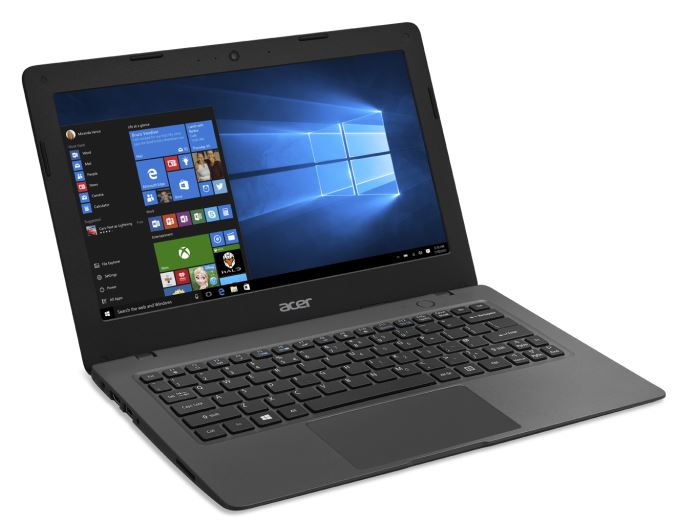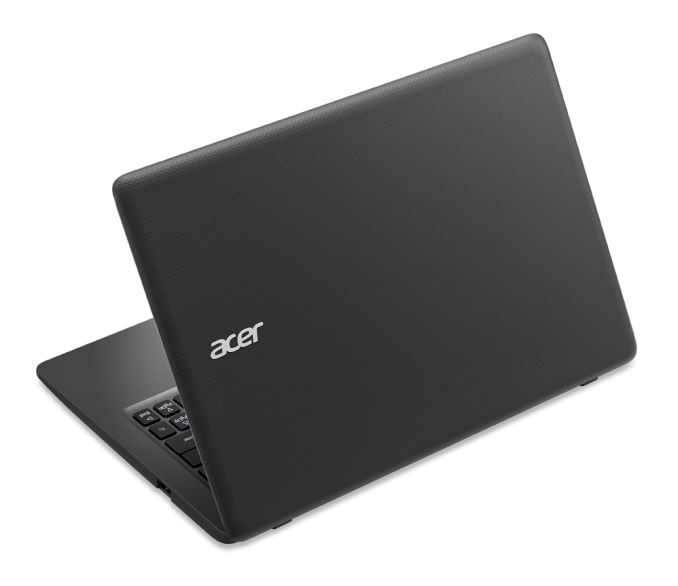Acer Announces Ultra Low Cost Cloudbooks With Windows 10 Home
by Brett Howse on August 4, 2015 5:00 AM EST
Today Acer is launching a new line of low cost notebooks, which are branded as Acer Aspire One Cloudbooks. There will be an 11.6-inch model, and a 14-inch model, and Acer manages to get both models under $200. We have seen some surprisingly decent notebooks around this price range, such as the HP Stream 11, but Acer has managed to move the barrier to entry even farther down.
The 11.6-inch model starts at only $170, with a bump in storage boosting the price to $190, or for $199.99 you can step up to the 14-inch model. For this price you get a 1366x768 resolution display, which is likely going to be a TN panel. The fanless design is powered by the 14nm Intel Celeron N3050 processor, which is a dual-core model with a base frequency of 1.6 GHz and turbo frequency of 2.16 GHz. This is going to be Airmont cores, similar to the previous N series Celerons with Silvermont. Performance expectations should be in check, but with a 6 watt TDP it should be able to maintain its peak frequency fairly well. As a comparison, the Surface 3 has four Airmont cores at up to 2.4 GHz, but with just a 2 watt scenario design power. Graphics will also get a boost over the older Celerons, with the Airmont cores now paired with Gen 8 graphics and 12 execution units rather than just 4 Gen 7 units available on the older chips.
One of the ways Acer was able to hit these price points was due to the storage available. The 11.6-inch model starts with just 16 GB of storage, and even with the Windows 10 storage features which can save even more space than Windows 8.1’s WIMBoot, 16 GB is not a lot for a Windows install. For those interested in this device, the $20 boost to 32 GB would be a wise investment. The 14-inch model starts with 32 GB and will also offer a 64 GB model later on. There is a SD card slot, but Windows 10 has not yet implemented the same features as Windows Phone has for SD card use, so no Windows Store apps can be installed to it yet, although that is coming later.
| Acer Aspire One Cloudbook | ||||||
| Cloudbook 11 | Cloudbook 14 | |||||
| CPU | Intel Celeron N3050 Dual-core Airmont 1.6-2.16GHz Intel HD Graphics 12 EUs 320-600MHz |
|||||
| Memory | 2GB DDR3L | |||||
| Storage | 16-32 GB eMMC | 32-64 GB eMMC | ||||
| Display | 11.6" 1366x768 | 14.0" 1366x768 | ||||
| Ports | USB 3.0 x 1 USB 2.0 x 1 HDMI SD Card Slot Headphone |
|||||
| Networking | 802.11ac WiFi Bluetooth 4.0 |
|||||
| Dimensions | H: 0.70" (17.8 mm) W: 11.5" (292.1 mm) D: 7.95" (201.93 mm) |
H: 0.70" (17.8 mm) W: 13.36" (339.3 mm) D: 9.25" (235.0 mm) |
||||
| Weight | 2.54 lbs (1.15 kg) | 3.5 lbs (1.59 kg) | ||||
| Battery Life | Up to 7 hours | Up to 6 hours | ||||
| Price | $169.99-$189.99 | $199.99+ | ||||
Both models will feature 802.11ac wireless, which is nice to see since that seems to be one of the first cuts on a budget notebook. Acer is positioning these devices as Cloudbooks, and they include one year of Office 365 Personal and the included 1 TB of OneDrive storage, and Acer is also promoting their cloud based abApps to help in keeping files in sync with smartphones and tablets.
While inexpensive, Acer has done well with the design. Both models are just 0.7-inches thick, and the smaller device comes in at just 2.54 lbs, and the larger 14-inch model tips the scales at 3.5 lbs. The textured pattern is finished in a mineral grey which looks quite sharp.
The Acer Cloudbooks will be available starting this month for the 11.6-inch model, with the 14-inch version coming in September.
Source: Acer












45 Comments
View All Comments
Morawka - Tuesday, August 4, 2015 - link
Dont see how you can use 16GB on these.. i have a venue 8 pro with 32GB and i only have 3 GB free space with clean windows 32bit install. no apps installed at all.SaolDan - Tuesday, August 4, 2015 - link
Windows 10 32bit on my dell venue 8 takes about 10 GB. i think the 32bit is the "bing edition"ET - Tuesday, August 4, 2015 - link
That's weird. I have 7GB of 32GB free on my equivalent ASUS tablet, with some software installed (although most of it is on the SD card). That's with a fully updated Windows 8.1 install.SaolDan - Tuesday, August 4, 2015 - link
Windows 8.1 that comes in the first dell venue 8 pro and the asus vivotab 8 is not the bing edition. Do a clean windows 10 32bit install and you will see.Alexvrb - Wednesday, August 5, 2015 - link
It has nothing to do with "bing edition" or anything else. They introduced WIMBoot at some point with Win8.1 to free up space. A lot of low-storage devices came with WIMBoot by default. Older devices, ones with lots of storage, and anything with a HDD would not have WIMboot and thus the Windows footprint would be larger. You can always convert older setups to use WIMBoot, not sure if Win10 defaults to this or not. I would NOT use WIMBoot on a HDD at all, and it's not really necessary on a large enough drive of any variety.I would definitely be interested to know if all fresh (NOT upgrade) Win10 installs default to WIMBoot, or if they use some criteria to determine when to use it and when not to bother.
Anyway bottom line is that in many cases 16-32GB could be enough especially with an SD card slot.
SaolDan - Thursday, August 6, 2015 - link
What AlexVRB said. :)menting - Tuesday, August 4, 2015 - link
I had 15G left on my Venue 8 Pro 32GB after a clean Win10 install.marvdmartian - Tuesday, August 4, 2015 - link
While I wasn't able to purchase it quite as cheaply as the 11" model shown, above, my old netbook (same size screen, with 160GB hdd, and 4GB ram) weighs in at around the same as this "cloudbook". Since they're saving weight by having just 16GB of flash memory, I have to assume the battery on this thing is exceptional. Otherwise, it really wouldn't be worth looking at, IMHO.Two thoughts, concerning this type of cloud device:
1. I really wish they would go ahead and give the option for an owner to add an SSD, instead of relying on the cloud. Sorry, but for security purposes, an onboard storage device will always beat easily hackable cloud services!
2. Since it has a USB port, I believe I would purchase a small SSD for storage, and put it inside an external case. Little to no draw off the battery, and accessible for times that you don't have a WiFi connection available.
ET - Tuesday, August 4, 2015 - link
IMO SD card is the way to go on such machines. It's slower than an SSD but you typically don't really need high speed for what you'll be storing there. (Though I have to wonder if the SD card is connected on a USB 2 bus, as sometimes happens, or can be used at full speed.)marvdmartian - Wednesday, August 5, 2015 - link
Maybe so, but with external cases running (on sale) as low as $10, and just yesterday, Newegg had a 120GB Sandisk SSD for $45, you can't really match the storage capacity with SDHC cards, for that price.